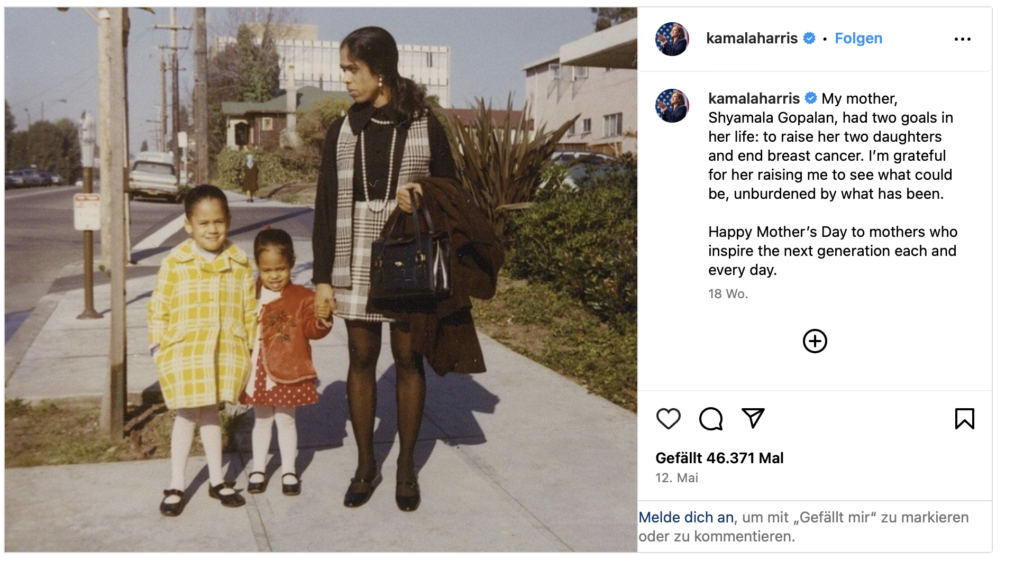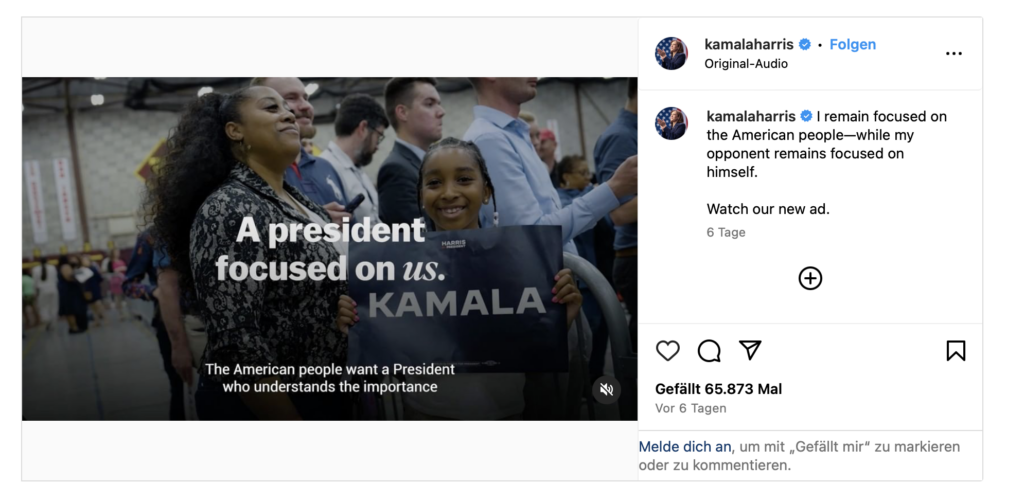Storytelling on the political stage: Kamala Harris and the power of the personal narrative
In the age of digital media and information overload, it is more important than ever to stand out from the crowd with a powerful and authentic story. This is true for personal branding in business, but also especially for political campaigns. One of the international political figures who has mastered storytelling is Kamala Harris – the first female Vice President of the USA and former and current Democratic candidate in the 2024 presidential election campaign. This blog post looks at how Kamala Harris uses her personal story as the core of her communication strategy, how she has developed her narratives and what lessons can be learned from this for personal branding in politics and business.

Kamala Harris and her personal story: The beginning
Kamala Harris was born in Oakland, California, in 1964 to an Indian mother and a Jamaican father. Her background and childhood experiences of exclusion shaped Harris’ worldview and her desire to promote social justice. The impressive careers of her mother as a breast cancer researcher and her father as an economist additionally perfectly embody the American dream. These stories therefore logically form the core of her political storytelling. Harris has consistently used her experiences as a child of immigrants, as an African-American and South Asian woman, and as a prosecutor to connect emotionally with voters.
During her 2020 presidential campaign, Harris frequently emphasized her role as the daughter of immigrants, her experiences as a “woman of color” and her career as a prosecutor fighting for civil rights and social justice. These narratives have allowed her to not only outline her political viewpoints, but also convey the values and motivations that drive her.

Storytelling in the 2024 election campaign: the evolution of her story
In the current 2024 election campaign, Kamala Harris continues to use her personal story as a central element of her communication – but with a broader focus. Now as the incumbent Vice President of the United States, she places particular emphasis on her political achievements and her leadership role. Her stories show how she has used her position to bring about change, improve people’s lives and stand up for disadvantaged groups.
1. focus on political achievements and leadership role
In the 2024 election campaign, Harris highlights her political successes and her leadership role as Vice President. She tells stories about her work in the Biden administration, how she made important decisions and overcame challenges – from dealing with the COVID-19 pandemic to representing the US internationally. These stories are meant to show that she is not just a political figure, but a true leader capable of delivering results.
Harris uses these narratives to underpin her political skills and her ability to deliver concrete results. She illustrates that she is not only willing to take responsibility, but also has the experience and determination to effect positive change.
2. emphasizing the personal connection to important voter groups

In her 2024 campaign, Harris emphasizes her identity as the first female vice president of the United States and uses this position to target voter groups that are often underrepresented – such as women, people of color and immigrants. She tells stories of women fighting against adversity and shows how her own experiences as the “first and only” in many areas have sensitized her to these struggles.
These narratives create a deeper emotional connection with voters and minority groups by strengthening their sense of representation and inclusion. Harris positions herself as an advocate for these communities and uses her story to show that she understands the concerns and needs of these people and is determined to fight for them.
3. stories of change and resilience
Another core element of her storytelling in the current election campaign is the emphasis on resilience and change. Harris tells stories about the challenges she has overcome in her career and life – from her childhood to her time as a prosecutor to her time as Vice President. These stories are meant to show her ability to persevere in difficult times and find constructive solutions. She uses these stories to present herself as a steadfast leader who never gives up and is always looking for ways to improve people’s lives.
4. digital storytelling: using new media formats and platforms
Harris is also increasingly relying on digital storytelling in the 2024 election campaign and is jumping on current trends in social media. In addition to more traditional social media such as X and Instagram, she is also using TikTok and podcasts to reach younger voters. On these platforms, she tells her stories in modern, short videos, shares personal anecdotes and lets people who have benefited from her work have their say.

A notable example of how she picks up on current social media trends is the “Brat Girl Summer” campaign. This trend originally emerged as a meme in response to singer Charli xcx’s album “Brat” and was humorously used to celebrate women who are confident and independent – a message that aligns with Harris’ personal and political brand identity. Rather than ignoring the meme, her team took the opportunity to adapt it into the design of her social channels, among other things, to strengthen her online presence and reach. The slogan “Kamala is brat” was given a positive spin, portraying Harris as a confident and assertive leader who remains strong even in difficult situations.
Kamala Harris also conquered the internet and TikTok in particular with a single sentence from a speech on May 10, 2023 about educational equality. She recounted an anecdote from her childhood in which her mother said: “I don’t know what’s wrong with you young people. You think you just fell out of a coconut tree?” This quote went viral and again attracted a lot of attention after Joe Biden withdrew from the campaign for the US presidency. Supporters of Harris then posted coconut emojis alluding to the speech as a humorous sign of their support.
These approaches show how flexible and creative Harris’ team is in adapting social media trends to spread her message and connect with younger voter groups in a humorous and accessible way. Through this clever use of trends and adapting to new media formats, Harris is able to reach a wider audience and spread her narrative in an innovative and dynamic way. This underlines the importance of a flexible and up-to-date digital strategy in a modern election campaign.
What can politics and business learn from Kamala Harris’ election campaign? Tips for effective personal branding
Kamala Harris’ storytelling strategies in the 2024 election campaign offer valuable insights for anyone looking to strengthen their personal brand – whether in politics or business. Here are some concrete tips you can learn from her approach:
1. using political or professional achievements as part of the personal narrative: Successful storytelling means incorporating your successes into your personal narrative. Show the challenges you have overcome and the results you have achieved. This creates credibility and builds trust.
2. addressing specific target groups: Clearly define which audiences you want to reach and develop specific stories that appeal to those groups. Kamala Harris uses her personal story to reach different communities – from women to immigrants to young voters. Tailor your narrative to the needs and interests of your target groups. However, it is important to always remain honest and authentic and not pander.
3. developing your own story: A strong personal story should evolve over time. Use new experiences, successes and challenges to update your narrative and stay relevant. Just as Harris has expanded her story from immigrant daughter to vice president, it should reflect your personal journey.
4. using new media to share stories: Utilize a variety of platforms and formats to share your stories. Harris has evolved her digital strategy to utilize platforms like TikTok and podcasts. Be willing to experiment with new media formats to increase your reach and reach your audience in innovative ways.
5. using resilience as a central message: In uncertain times, resilience can be a crucial message. Tell stories about how you have overcome challenges and how you have remained strong in difficult times. This message can help you to be perceived as a reliable and steadfast leader.
Conclusion: telling an authentic story with your own experiences
In the 2024 election campaign, Kamala Harris shows how powerful storytelling can be when used authentically and strategically. Her ability to continuously develop her personal story and adapt it to the current political and social contexts makes her an inspirational figure in the political landscape. For anyone working in politics or business, her approach offers valuable insights into how to build trust, evoke emotion and develop a strong personal brand through powerful and authentic storytelling.
Share this article







